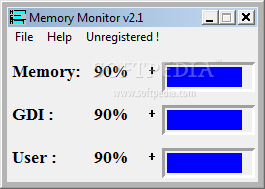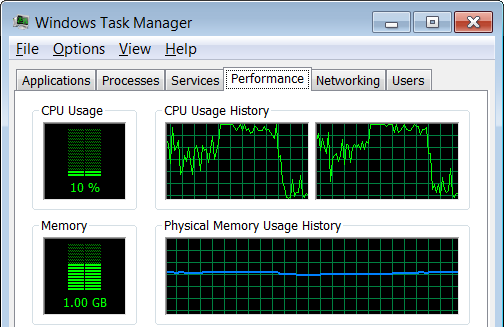
- #Memory monitor xp update#
- #Memory monitor xp windows 10#
- #Memory monitor xp software#
- #Memory monitor xp code#
- #Memory monitor xp windows#
#Memory monitor xp windows#
The "System Monitor" naming was kept in Windows XP. In Windows 2000, the System Monitor of Windows 9x and the Performance Monitor of Windows NT 4 and earlier, as well as another program called Network Monitor, were merged into a Microsoft Management Console (MMC) plug-in called Performance, which consisted of two parts: "System Monitor" and "Performance Logs and Alerts". Other possible categories include Microsoft Network Client, Microsoft Network Server, and protocol categories. The categories of information that can be monitored depends on which networking services are installed, but they always include file system, kernel, and memory manager.
#Memory monitor xp update#
Performance Monitor can display information as a graph, a bar chart, or numeric values and can update information using a range of time intervals. In contrast, the Windows NT Performance Monitor is available out-of-the-box and has over 350 performance measurement criteria (called "counters") available. It has few counters available and offers little in the way of customization. In Windows 9x, System Monitor is not installed automatically during Windows setup, but could be installed manually using the Add/Remove Programs applet, located in the Control Panel.
#Memory monitor xp software#
This type of application may be used to determine the cause of problems on a local or remote computer by measuring the performance of hardware, software services, and applications. It monitors various activities on a computer such as CPU or memory usage.

Performance Monitor (known as System Monitor in Windows 9x, Windows 2000 and Windows XP) is a system monitoring program introduced in Windows NT 3.1.
#Memory monitor xp windows 10#
Simply try it for your own situation.Performance Monitor running on Windows 10 In some cases it can benefit workstation configurations, but it strongly depends on how the desktop is used. Also do not use this tweak on RAID systems as that can cause problems. This tweak is best used on servers and not on workstations. The LargeSystemCache value ensures that more system memory is used for the file system cache. Again set the value to 1 instead of 0 to enable it. The second value is called LargeSystemCache and resides in the same registry key.
#Memory monitor xp code#
The kernel code will not be swapped to disk (pagefile) anymore, ensuring the core OS functions are always immediately available. Setting this value to 1 instead of 0 will instruct Windows XP to keep its kernel (ntoskrnl.exe) in memory. In this key you will find a value called DisablePagingExecutive. HKEY_LOCAL_MACHINE\SYSTEM\CurrentControlSet\Control\Session Manager\Memory Management The first can be found in the following registry key: There are two more registry settings that can be used to configure memory usage in Windows XP that can help speed up systems with sufficient memory. If that’s the case, Windows XP can be configured to use the internal memory even more efficiently. Increasing the size of the paging file can also help solve out of memory problems. Remember that you can also try to increase the virtual memory of Windows XP. This Windows XP tweak should prevent many of the out of memory errors. Basically Windows allocates the maximum possible and then adjusts the value if the computer configuration changes. When Windows XP restarts, the operating system will try to allocate more system page table entries, depending on the internal amount of memory.

HKEY_LOCAL_MACHINE\SYSTEM\CurrentControlSet\Control\

If a DLL is not used anymore, it is not always unloaded from memory right away.Īnother reason is that Windows XP can not always make all available internal memory available to an application. Further some memory is not always immediately released, like DLL (dynamic Link Library) memory. Like a hard disk, memory can become fragmented. There are different reasons for this, one being the memory fragmentation in Windows XP.

You think you have a lot of memory (RAM) in your computer and still you are getting out of memory errors? This can indeed happen if you are running many applications or memory intensive applications under Windows XP.


 0 kommentar(er)
0 kommentar(er)
